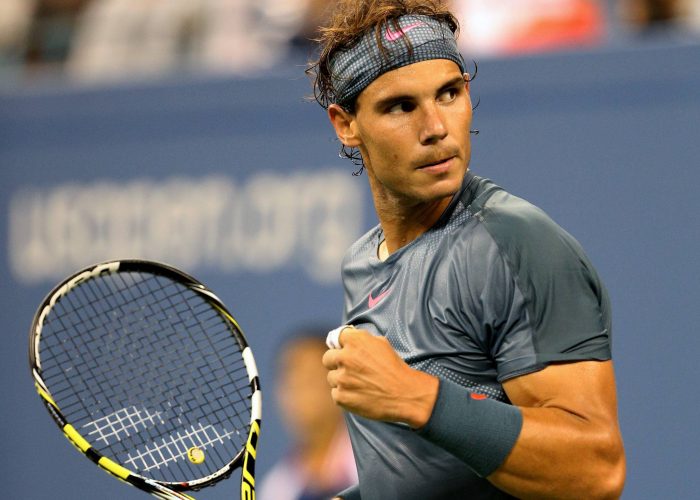



Rafael Nadal won his 10th French Open wearing a US$750 000 watch.
IF you’re trying to understand how it’s possible that a 31-year-old, injury-prone Rafael Nadal was able to blitz the competition at Roland Garros, capturing La Decima, his record-setting tenth French Open title, without so much as dropping a set, you will not find the answer in Sunday’s final, where he defeated fellow geezer and 2015’s French Open champion, Stan Wawrinka, 6-2, 6-3, 6-1.
Nor will you find it in his semi-final match versus rising star Dominic Thiem, a showdown that might have offered some suspense—the Austrian being Nadal’s only consistent foe on clay this year, beating him once in Rome—but didn’t, as Nadal swatted the youth away, winning 6-3, 6-4, 6-0.
In those one-sided matches, all of Nadal’s familiar weapons, the ones he’s used to rule the clay for over a decade, relentlessly fired away.
His movement on the tricky, punishing surface remains both explosively fast and controlled, allowing him to sprint behind the baseline, returning would-be winners and then, before his opponent can adjust, advance offensively, sliding to the net with ease on the loose top layer of sand to execute a perfect drop shot.
His lefty forehand —and let’s call it what it is: cruel—bluntly pummeled every rival’s backhand, picking away at their strength and will, displaying, yet again, that no player understands better than Nadal how to use a single shot to methodically demoralize an opponent. Hit with heavy topspin, which causes the ball to bounce higher—an effect magnified on clay—Nadal’s forehand forces opponents to take the ball awkwardly at their shoulders instead of at their waist. By knocking them back and off balance, Nadal patiently, ruthlessly, dismantles players, exhausting the mind well before the body.
But if you really want to see why Nadal is still winning in 2017—why he’s defying the expectations of fans and journalists who, pointing to his three-year Slam drought and his chronic knee and wrist pain, lined up in 2016 to eulogize him, claiming all that remained was the painful task of watching a former great age and fade away—you have to watch a specific moment in his third-round match against Nikoloz Basilashvili. It occurs in the second set, when, in the middle of Nadal’s service game, Basilashvili sees he’s popped a string on his racquet and trots over to his bench to exchange it for a new one. At first the crowd calls out some encouragement for the poor Georgian, who is woefully outmatched, but quickly the applause turns to jeers as the crowd notices Nadal’s reaction to the interruption he’s seething. Granted, no player, least of all the neurotically ritualistic Nadal, wants their rhythm broken on serve, but look at this moment in its proper context: Nadal has already won the first set, 6-0, and is up a break in the second. That Nadal has been in complete control has been evident from the first few groundstrokes of the match, and yet, Nadal is furious, stalking his service spot, kicking up clouds of dirt; he glares at the back of Basilashvili and then turns to the crowd, as if to command them to share his disgust. And they obey, booing now, shouting down to the court that Basilashvili is taking too long and must report back to the baseline for the slaughter.
To me, this is the most breath-taking moment of the entire tournament and the best evidence of Nadal’s greatness. Here exposed are the depths of Nadal’s single-minded, humourless need to crush all opponents, point after point, no matter the stakes, no matter the score. Where other players might have feigned patience, or even a bit of sympathy for the opponent they were brutalizing, Nadal had nothing but palpable contempt. He’d go on to take the match, 6-0, 6-1, 6-0, the most lopsided best-of-five victory of his career, but the blowout of Basilashvili meant nothing to Nadal in that moment. The only thing on his mind then was the only thing ever on his mind: win this point. Tennis is a grueling, lonely sport played eleven months out of the year and so it is expected that even top players will have dips in focus and motivation. It’s also not uncommon to watch a brilliant player completely disintegrate after giving up a tough first set, as Nick Kyrgios did this year in the second round against Kevin Anderson or as 2016’s French Open champion, Novak Djokovic, did against Thiem in the quarter-finals. When a player can’t reset mentally in between points, a small deficit can balloon quickly into an insurmountable one. It’s hard not to sympathize with the loser in these moments. Exhaustion, self-doubt, flagging desire: these are just human problems. But Rafael Nadal reminds us that the best in any sport exceed not just our expectations of what an athlete can do physically, but what a human can do mentally. Nadal cares, with superhuman seriousness, about every game, every shot. You cannot coach a player to want to win as much as Nadal wants to win. It has to arise from some roiling, unquenchable, internal compulsion to be great.
By the time Nadal hoisted La Coupe des Mousquetaires above his head, he’d lost a mere 35 games in seven matches, the fewest for a Slam champion since Björn Borg’s 1978 win in which he dropped only 32. While not unbeatable on other surfaces, Nadal, like Curry behind the arc, owns his corner like no one else in the history of the sport. His record at Roland Garros now stands, absurdly, at 79-2, bringing his career record on clay to 389-35. While awe-inspiring, a display of such utter dominance does not always make a particularly gripping tournament for spectators. Roger Federer—the only person able to consistently beat Nadal in 2017, so far taking all three of their meetings—chose to skip the French Open, eliminating the possibility of another Slam matchup between the bruising Nadal and his graceful nemesis. The inevitability of a Nadal victory drained the tension from the rest of the men’s draw, casting a pall over even the thrilling semi-final five-setter between Wawrinka and Andy Murray, as those who watched sensed the victor would be awarded only a better view of Nadal’s trophy ceremony 48 hours later. But what this year’s French Open lacked in intrigue, it made up for by offering ticket holders the opportunity to see Rafael Nadal, the greatest clay-court player of all time, operate injury-free and at the height of his genius. – www.gq.com